Physical Address
304 North Cardinal St.
Dorchester Center, MA 02124
The first successful venous reconstruction in a patient was reported more than 50 years ago by Warren and Thayer ; in the past 2 decades improvements in diagnosis, patient selection, surgical technique, and the availability of better graft materials have resulted in more frequently successful implantation of venous bypasses in patients. More recently, endovascular treatment for iliocaval obstruction has progressed rapidly, and currently venous stenting is the primary choice for treatment of benign iliac or iliocaval venous occlusions. However, surgical treatment remains an excellent option in cases in which endovascular techniques have failed or are not possible. The endovascular treatment for iliocaval obstruction is addressed in Chapter 161 (Iliocaval Venous Obstruction: Endovascular Treatment).
Deep venous thrombosis (DVT) is the most common cause of venous obstruction. Venous occlusion may also be due to trauma, radiation, external compression by retroperitoneal fibrosis or overlying arteries (May–Thurner syndrome), , benign, malignant, primary, or metastatic tumors ; cysts; aneurysms; abnormally inserted muscle bands (popliteal vein entrapment) ; and fibrous bands or ligaments (soleal arch syndrome, femoral vein compression by the inguinal ligament ).
Compression of the left common iliac vein by the overriding right common iliac artery (May–Thurner syndrome) ( Fig. 160.1 ) is considered an important cause of left iliofemoral venous thrombosis. May and Thurner observed secondary changes, such as intraluminal webs or “spurs,” in the proximal left common iliac vein in 20% of 430 autopsies. , Other causes of iliofemoral and caval thrombosis include congenital anomalies, such as membranous occlusion of the suprahepatic inferior vena cava (IVC) with or without associated thrombosis of hepatic veins (Budd–Chiari syndrome), aplasia, and hypoplasia of the iliofemoral veins as in Klippel–Trénaunay syndrome. ,
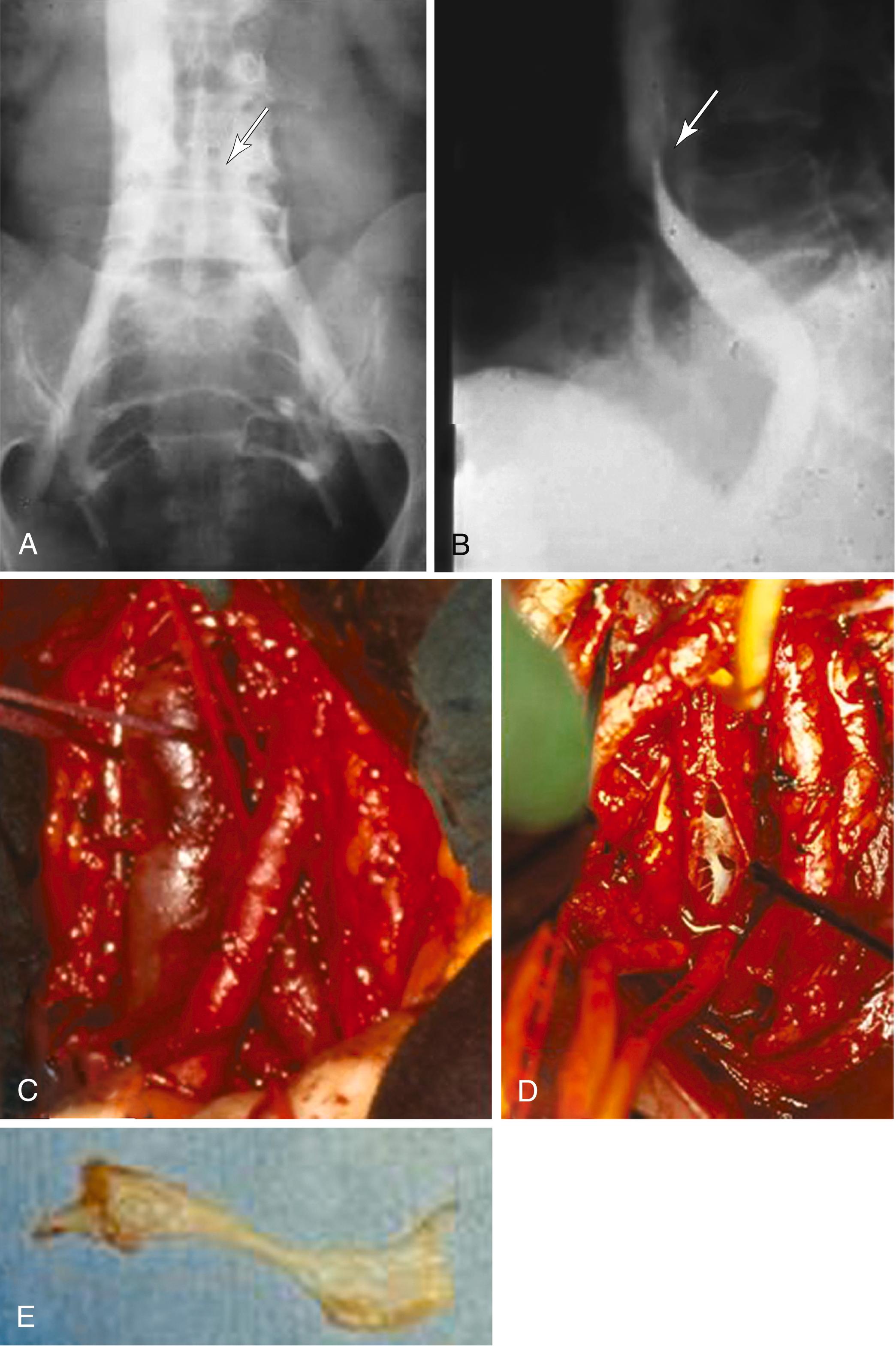
Preoperative evaluation in patients with iliofemoral and/or iliocaval venous obstruction should reveal the cause and functional significance of the obstruction and the extent and severity of associated venous incompetence. In at least two-thirds of patients with venous outflow obstruction, distal reflux due to valvular incompetence contributes greatly to development of chronic venous insufficiency (CVI).
The history and physical examination, complemented by examination with a handheld Doppler instrument, should reveal signs and symptoms typical of venous congestion. Patients have lower extremity swelling and experience exercise-induced pain in the thigh muscles, referred to as venous claudication. This pain is described as a “bursting” pain in the thigh and sometimes the calf, which is relieved by rest and leg elevation.
Signs of CVI, such as edema, varicose veins, skin changes, lipodermatosclerosis, eczema, and ulceration, should be noted. Distended varicose veins are present even in the supine patient with CVI, and suprapubic and abdominal wall collaterals develop in patients with pelvic occlusion. Bleeding from high-pressure varicosities is not infrequent. The swollen leg has a cyanotic hue, and bilateral swelling indicates bilateral iliofemoral or vena caval occlusion or systemic disease. In some patients, venous congestion results in hyperhidrosis and significant fluid loss through the skin. Associated chronic high-output or low-output lymphedema may also develop.
Preoperative evaluation should identify risk factors for DVT (see Chs 146 , Acute Deep Venous Thrombosis: Epidemiology and Natural History and 148 , Acute Lower Extremity Deep Venous Thrombosis: Presentation, Diagnosis, and Medical Treatment). Associated chronic arterial occlusive disease and congenital venous malformations (Klippel–Trénaunay syndrome, Parkes Weber syndrome) should be excluded. Patients with membranous occlusion of the vena cava frequently also have evidence of hepatic failure, Budd–Chiari syndrome, and portal hypertension.
Duplex ultrasound scanning (DUS) is the first test of choice to identify DVT. However, depending upon factors such as the presence of overlying bowel gas and increased body fat, the IVC and proximal iliac veins may be difficult to image in enough detail to guide further treatment. In these cases, computed tomographic venography (CTV) or magnetic resonance imaging (MRI) can be performed. These tests are also important in identifying causes of iliocaval venous thrombosis, including tumor, cyst, retroperitoneal fibrosis, and iliac venous compression.
Abnormal DUS findings associated with iliocaval occlusion, such as absent flow in the iliac veins and loss of phasicity of flow in the distal veins, are discussed more fully in Chapters 25 (Vascular Laboratory: Venous Duplex Scanning) and 156 (Postthrombotic Syndrome: Natural History, Pathophysiology, and Etiology).
Ambulatory venous pressure measurements may suggest venous hypertension; measurements of arm–foot pressure differences, as described by Raju can also be used to quantitate venous hypertension. In their study a resting arm–foot pressure differential greater than 4 mm Hg was considered evidence for significant obstruction justifying venous reconstructions. In potential candidates for proximal venous reconstruction, femoral and central venous pressure measurements are required in our practice to document the severity of iliac or iliocaval obstruction. Either a pressure difference of at least 5 mm Hg between the femoral and the central pressures in the supine patient or a twofold increase in femoral vein pressure after exercise indicates hemodynamically significant proximal stenosis or occlusion.
In patients being considered for venous reconstruction, we perform both ascending and descending catheter-based phlebography to evaluate obstruction and associated valvular incompetence. , Femoral access is useful not only for descending phlebography and iliocavography but also for measuring femoral venous pressures. Iliocavography and abdominal venacavography through a brachial approach may also be necessary in some patients to visualize the vena cava proximal to the occlusion.
Prior to the development of endovascular techniques for the treatment of venous disease, surgery was the only option following failures of conservative management. However, with the development and success of advanced endovascular treatments (see also Ch. 161 , Iliocaval Venous Obstruction: Endovascular Treatment), surgery is now generally reserved for cases in which endovascular treatment fails or is deemed inappropriate. The severity of venous stenosis, the location and length of venous occlusion, the age of the thrombus, the nature of any external compression, the presence of underlying malignant disease, and the risks of surgical intervention also play a role in determining whether to attempt endovascular or direct surgical reconstruction. Currently, we first attempt endovascular treatment, alone or in combination with thrombolysis, surgical thrombectomy, or excision of old thrombus from the femoral veins, before a surgical bypass is recommended.
Proper patient selection is important; the ideal patient has unilateral iliac occlusion with minimal distal thrombus and valvular competence. Patients with severe infrainguinal post-thrombotic disease and valvular incompetence may have a decreased chance of success because the distal disease is not treated. In a series published by the Mayo Clinic, there was a trend toward a higher rate of graft occlusion in patients with infrainguinal reflux.
Grafts placed in the venous system undergo thrombosis more frequently than those implanted for arterial reconstruction, in part because flow in venous grafts is lower. Pressure in the venous system is low, and grafts can collapse under increased abdominal pressure or in tightly confined spaces, such as the area under the inguinal ligament and the retrohepatic space, or when tunneled through the diaphragm. Many patients with previous DVT have hypercoagulable states. The thrombogenic surface of the prosthetic graft also increases the risk of graft failure.
As a result of extensive efforts made in the past decades, patency of grafts implanted in the venous circulation has improved considerably. The availability of large-diameter autologous and prosthetic grafts, use of adjuncts such as a distal arteriovenous fistula, rigid external support of the grafts, perioperative and postoperative anticoagulation, the use of perioperative intermittent-compression pumps, and postoperative surveillance with duplex scanning all contribute to improved patency and clinical outcomes.
Autogenous grafts for the femorofemoral, iliofemoral, and iliocaval locations have the best chance of long-term success. The great saphenous vein, because of its low thrombogenicity and suitability in terms of length, is the best choice when available. As a spiral or panel graft, it can be used for the reconstruction of large veins, although in our experience these grafts do not perform as well for iliocaval reconstructions as they do for superior vena caval replacement. , The contralateral superficial femoral vein, arm veins, and the jugular veins are other potential sources of autogenous grafts. Although harvesting of deep veins was initially believed to result in a high level of CVI in the lower extremity, more recent data suggest it is relatively benign in the majority of patients. The only factors found to be associated with venous morbidity following lower extremity deep vein harvest in a recent study were an ankle–brachial index less than 0.4 and a concurrent great saphenous vein harvest.
The efficacy of cryopreserved vein or arterial grafts in the venous circulation has not been well studied. A few reports exist regarding their use in reconstruction of the superior vena cava and innominate veins. Data at this point are insufficient to support the recommendation of these grafts for routine clinical use.
Of the available prosthetic materials, the expanded polytetrafluoroethylene (ePTFE) graft has been used most frequently for large vein replacement. , , , , , , Because of the large diameter, sufficient length, immediate availability, and external ring or spiral support associated with relatively low thrombogenicity, ePTFE grafts continue to be the best choice for prosthetic replacement of large veins.
Multiple studies have confirmed that a distal arteriovenous fistula, first suggested by Kunlin and Kunlin in 1953, improves the patency of grafts placed in the venous system. , , , , , An arteriovenous fistula increases flow and decreases platelet and fibrin deposition in prosthetic grafts ( Fig. 160.2 ). Prosthetic grafts have significantly higher thrombotic threshold velocities than do autologous grafts and require higher flow to maintain patency.
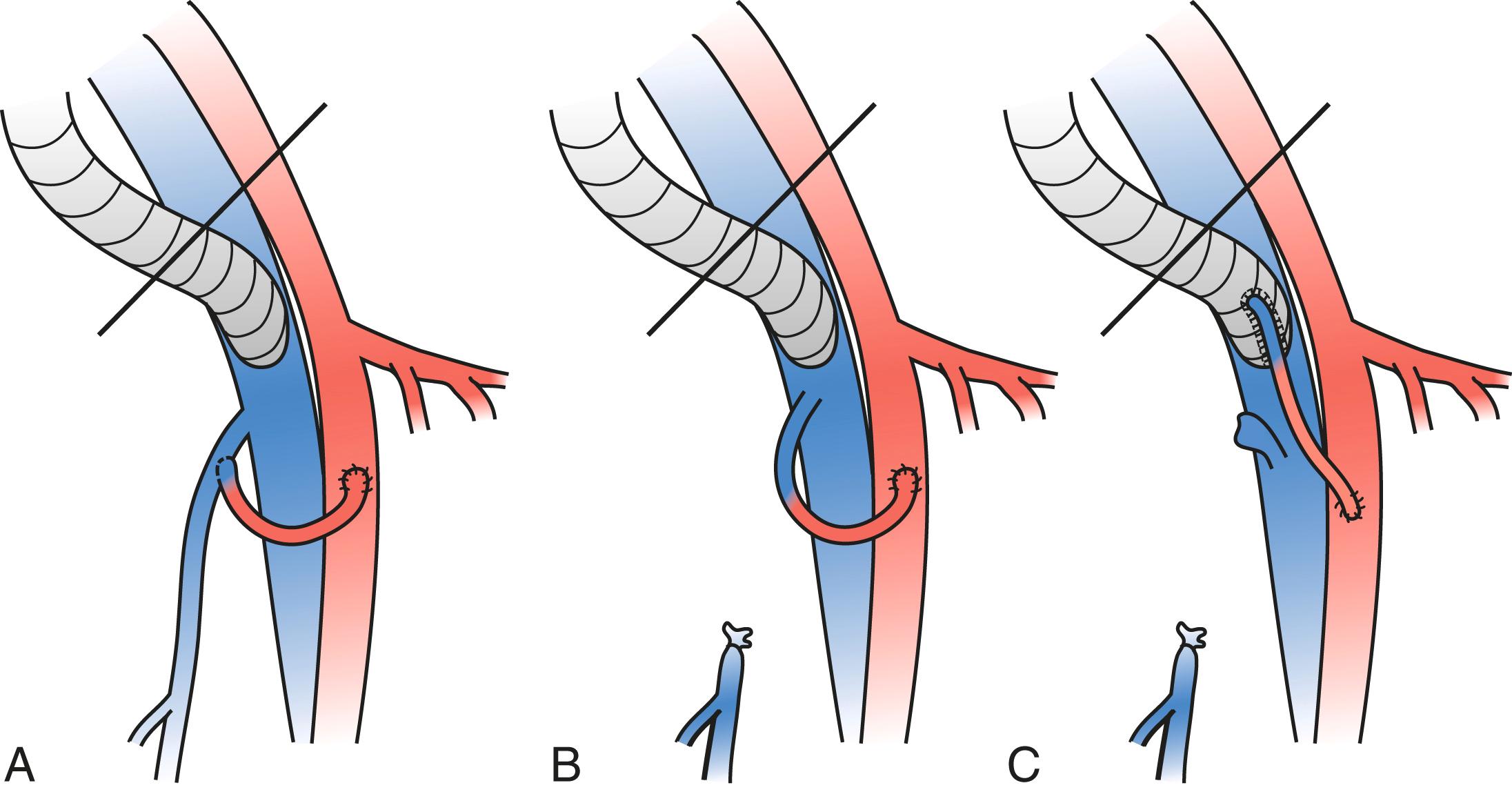
Disadvantages of an arteriovenous fistula include the longer operating time needed to create the fistula and the inconvenience of additional procedures to close the fistula at a later date. A potential side effect is elevated cardiac output caused by high fistula flow. In addition, high fistula flow can defeat the purpose of the operation by increasing venous pressure at the groin and causing more distal venous outflow obstruction. Experimental work revealed that to avoid deleterious effects on venous outflow from the leg, the optimal ratio between the diameters of the fistula and the graft should not exceed 0.3. Elevated intraoperative pressure in the femoral vein after placement of a fistula should be taken as a warning sign, and fistula diameter should be decreased by banding or other modifications.
The configuration and location of the fistula have also been the subject of much controversy. A large side branch of the great saphenous vein or the saphenous vein itself can be used to perform one anastomosis only. Most recently, we have placed the venous end of the arteriovenous fistula directly onto the hood of the venous graft at the distal anastomosis, using either a 4-mm vein as a free graft (saphenous vein or a large tributary) or a 4-mm ePTFE graft. The advantage of these is that flow can be calibrated with an electromagnetic flowmeter, and large flows (>300 mL/min) can then be avoided. The arterial anastomosis is usually made to the superficial femoral artery. The occlusion of the AV fistula is now currently performed endovascularly, by placing occlusion devices (coils, Amplatzer) in the fistula, through a contralateral arterial puncture. We also place a small polymeric silicone (Silastic) sheet around the fistula to prevent healing and to facilitate dissection of the fistula during a second procedure to occlude it, in case of endovascular failure. A 2-0 polypropylene suture is also tied loosely around the fistula, and its end is positioned in the subcutaneous tissue close to the incision for later identification. Intraoperative duplex scanning can be used later to identify the fistula. Percutaneous closure of the fistula with transcatheter embolization or a covered stent placed across the arterial side are also options.
At present, for all prosthetic grafts anastomosed to the femoral vein and all longer (>10 cm) iliocaval grafts, a femoral arteriovenous fistula is added to maintain patency (see Fig. 160.2 ). The fistula is left in place for at least 6 weeks after the operation, and patients without any side effects benefit from long-term fistula flow to prolong patency. For the Palma procedure (described later), we use a fistula selectively and take it down within 2 months after surgery.
Intravenous heparin, at a dose of 50 IU/kg, is given in surgery prior to cross-clamping, and anticoagulation is maintained during and after the procedure in most patients. We frequently administer low-dose heparin (500–800 IU/h) locally through a small polyethylene catheter placed just distal to the anastomosis in the perioperative period ( Fig. 160.3 ). This is continued until complete systemic heparinization is achieved by 48 hours after surgery. The catheter is then removed, heparinization is continued intravenously or by using low-molecular-weight heparin, and the patient begins oral anticoagulation therapy with warfarin.
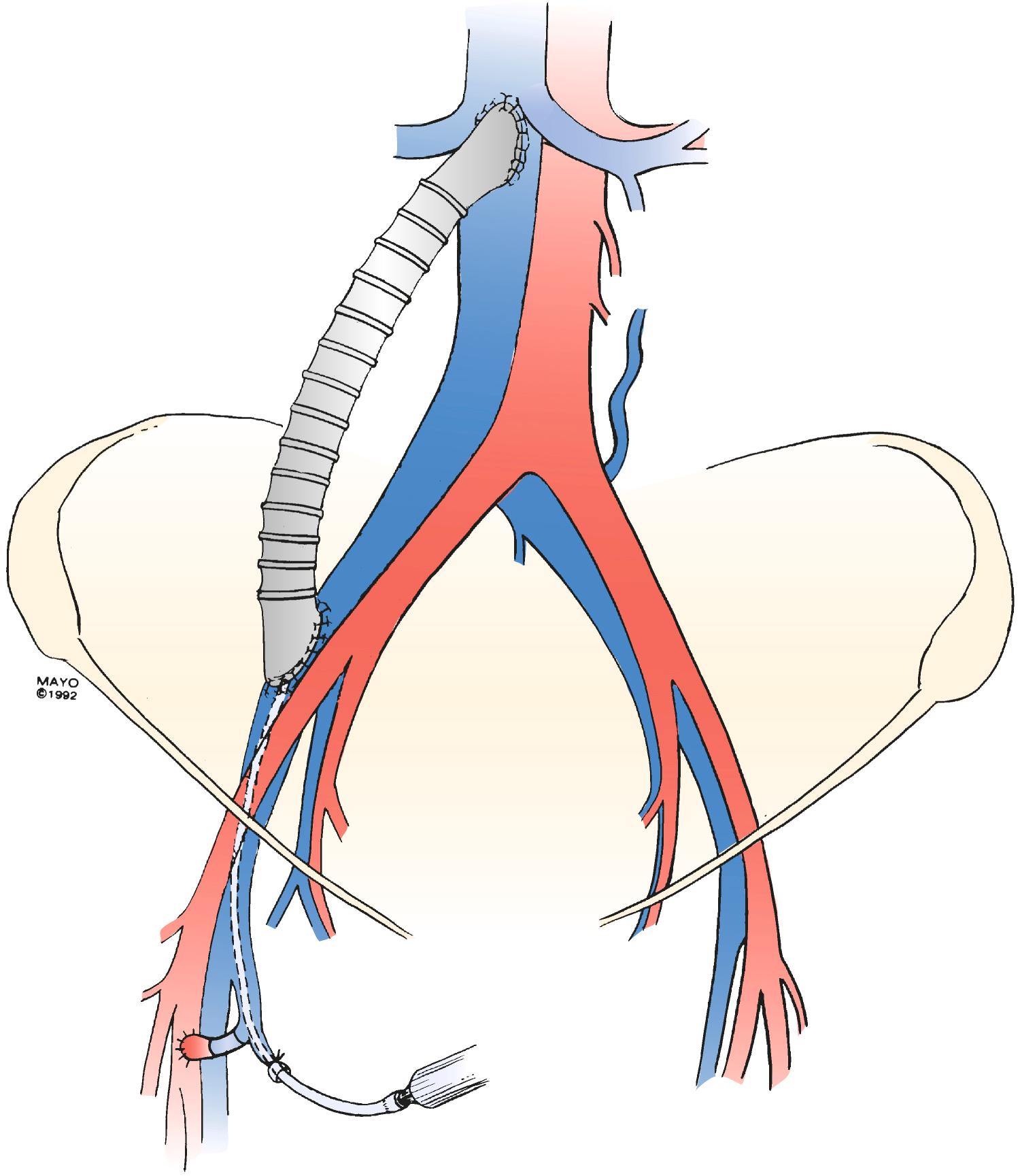
An intermittent pneumatic compression pump, leg elevation, elastic bandages, and early ambulation are also used in the perioperative period to improve the success of venous reconstruction. The patient is fitted with 30- to 40-mm Hg graduated-compression elastic stockings before discharge. Warfarin is continued in patients with autogenous grafts for at least 3 months. In most patients with prosthetic grafts or an underlying coagulation abnormality, oral anticoagulation is maintained indefinitely.
Intraoperative duplex scanning is performed in most patients to ensure patency, good flow, and lack of thrombus deposition. Direct pressure measurements are made before wound closure in every patient to document the hemodynamic benefit. In venous or ePTFE conduits, fistula flow can be measured and calibrated with an electromagnetic flowmeter. If flow is higher than 300 mL/min, banding of the fistula is performed.
On the first postoperative day, we perform contrast phlebography through the catheter positioned at the distal anastomosis of the graft (see Fig. 160.3 ). Any stenosis or thrombosis detected at this time is revised during a reoperation. Postoperatively, grafts are observed with duplex scanning at 3 and 6 months and then twice yearly thereafter. Outflow plethysmography is also performed to document the level of hemodynamic impairment/improvement in the lower extremity. In symptomatic patients, contrast phlebography is usually performed to exclude graft stenosis.
Initially described 40 years ago by Palma and Esperon , in Uruguay and popularized by Dale in the United States, the Palma procedure has remained a useful technique for venous reconstruction in patients with unilateral iliofemoral outflow obstruction ( Figs. 160.4 and 160.5 ). The operation requires a normal contralateral iliofemoral venous system to ensure venous drainage. Results have been better in patients with intact inflow, when the affected limb has no infrainguinal obstruction or deep venous incompetence. ,
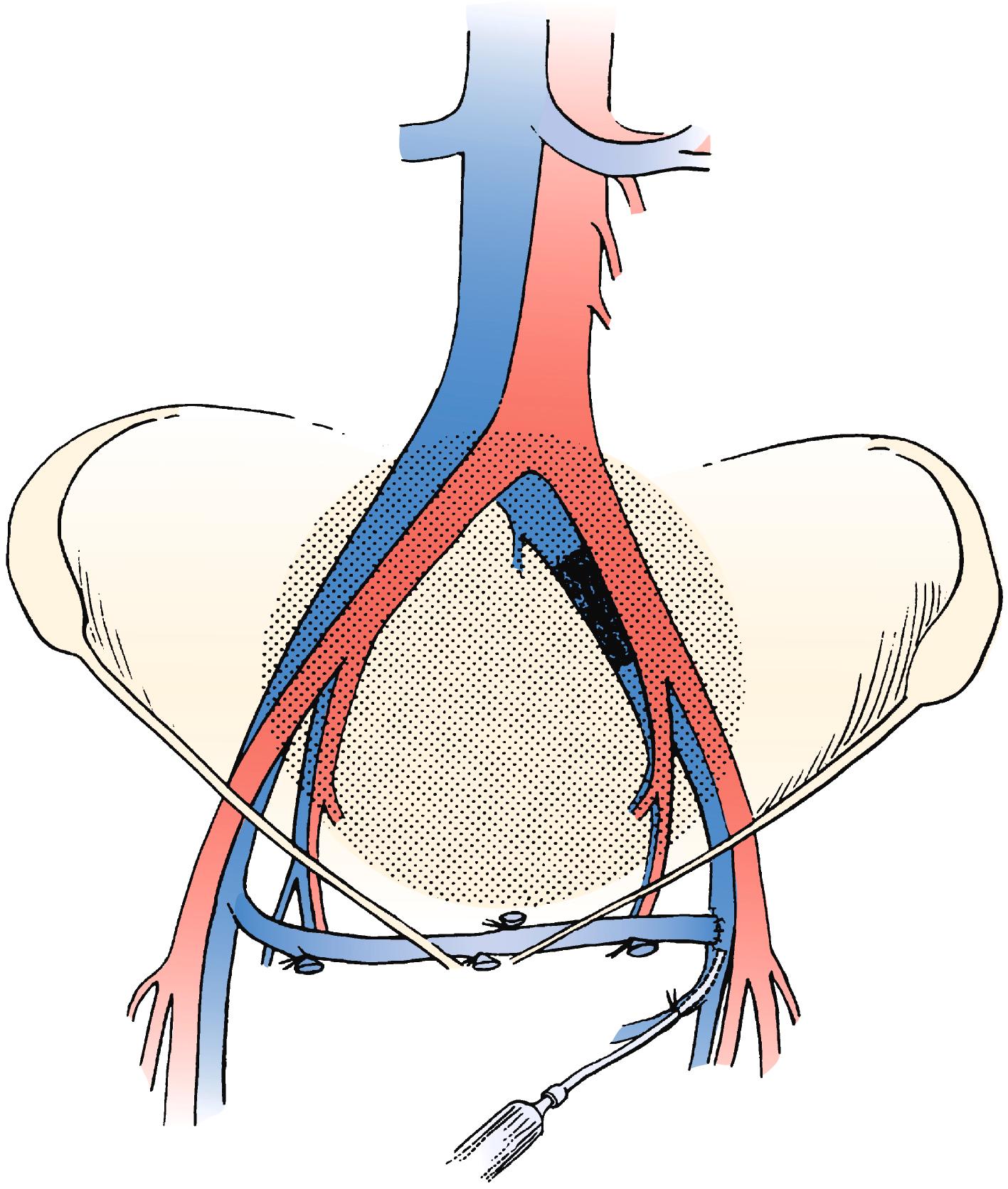
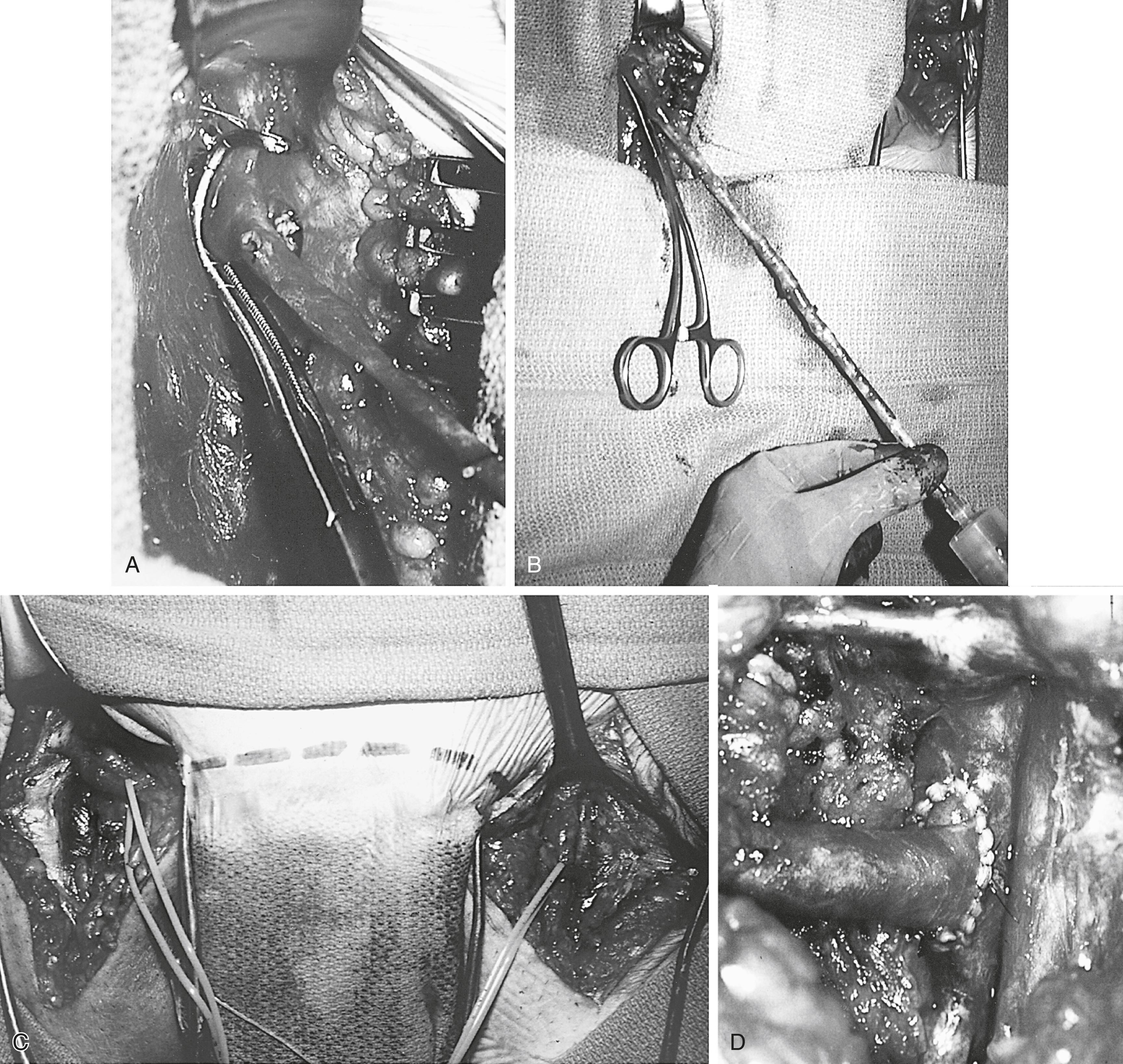
We favor this operation especially in young women who present with residual chronic iliac vein occlusion after acute left iliofemoral venous thrombosis which develops as a result of May–Thurner syndrome. The operation is indicated in patients who are not candidates for iliac vein stenting or in whom previous endovascular procedures have failed.
The contralateral great saphenous vein is used in the classic Palma procedure (see Fig. 160.5 ). Preoperative imaging of the potential conduit with duplex scanning is recommended because varicose saphenous veins or veins smaller than 4 mm in diameter have poor chances of long-term success.
Endoscopic harvesting of a 25- to 30-cm segment of the contralateral saphenous vein ensures an excellent cosmetic result; otherwise, the vein can be dissected through two or three small skin incisions. It is divided in the distal thigh or calf and remains attached at the saphenofemoral junction. Tributaries are also ligated and divided.
The graft is gently distended and tunneled to the contralateral groin in a suprapubic, subcutaneous position. Dissection of the femoral vein on the affected side should be minimal; usually, only the anterior and lateral vein wall is freed for proximal and distal clamps or for a side-biting clamp to occlude the vein for the anastomosis. Excision of intraluminal fibrous bands after venotomy may be required. The anastomosis between the saphenous and femoral veins is performed in an end-to-side technique. If the vein is small, interrupted 5-0 or 6-0 sutures are preferred to permit later dilation of the vein and to avoid “purse-stringing” of the venous anastomosis. A small catheter can be placed through a tributary of the ipsilateral saphenous vein for immediate low-dose heparinization and postoperative phlebography (see Fig. 160.5 ). A temporary arteriovenous fistula can also be placed to improve flow and aid in achieving early patency.
If the traditional transposition results in significant kinking of the saphenous vein at the contralateral groin, free vein grafting should be considered, excising the saphenous vein along with a small rim of the common femoral vein and reimplanting it after a 180-degree turn. For autogenous graft material, the contralateral or even the ipsilateral saphenous vein (with lysis of any competent valves) or an arm vein can be used. When suitable autogenous conduit is not available, an 8- or 10-mm externally supported ePTFE graft is the best alternative ( Fig. 160.6 ). ,
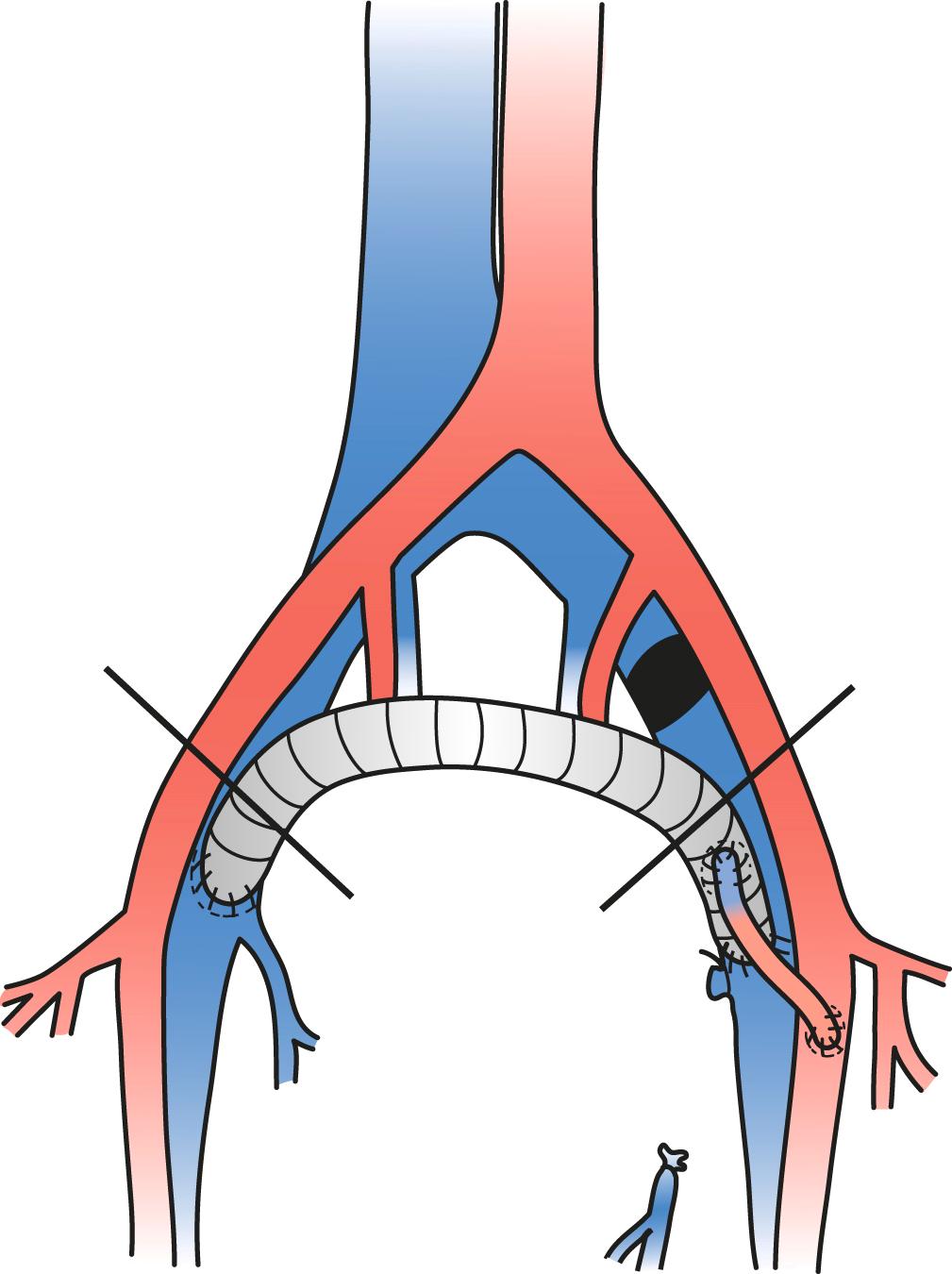
Become a Clinical Tree membership for Full access and enjoy Unlimited articles
If you are a member. Log in here